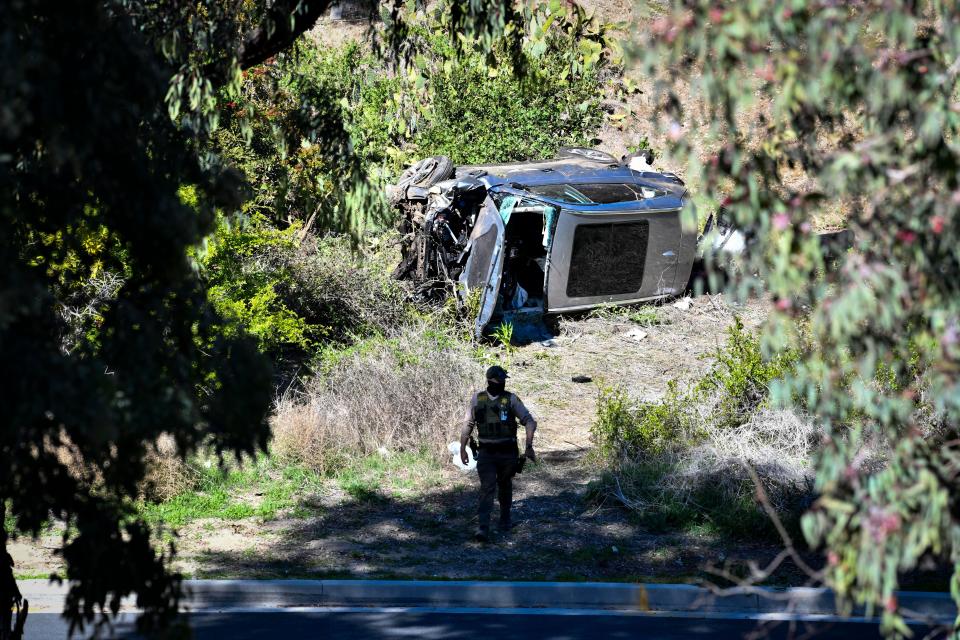What is a comminuted open fracture? Doctors explain Tiger Woods' leg injuries
- Oops!Something went wrong.Please try again later.
Tiger Woods escaped a Tuesday morning car accident with his life, but suffered "significant" leg injuries that required extensive surgery and a rod being inserted into his lower right leg.
Woods suffered "comminuted open fractures affecting both the upper and lower tibia and fibula" said Dr. Anish Mahajan, interim CEO and chief medical officer of Harbor-UCLA Hospital, where Woods was taken to the trauma center and treated.
"Comminuted" means there were multiple fragments of the tibia and fibula shattering, ESPN injury analyst Stephania Bell said on the network Wednesday morning. "Open fractures" are otherwise known as compound fractures, meaning the bone has protruded through the skin.
"This is all badness," Dr. Robert Glatter, emergency physician at Lenox Hill Hospital in New York City, told USA TODAY Sports on Wednesday. "From an orthopedic standpoint, it’s an emergency.
"I think he’s quite fortunate to be alive. The fact he had only isolate orthopedic injuries, that we know of so far, is pretty remarkable."
Doctors placed a rod through the tibia (goal is that bone heals around it), with a "combination of screws and pins" to stabilize additional bones in the ankle and foot, indicating multiple injuries in the area.
ROD INSERTED IN HIS LEG: Tiger Woods is 'awake, responsive' after surgery following car crash
KEEP INFORMED: Get the latest on Tiger Woods' injury and recovery. Sign up for our sports newsletter.

"Surgery takes a long time because they have to put the right tension on it, they have to reposition," Bell said. "They're trying to get anatomical alignment."
Dr. Sam Hawkins, a trauma surgeon at Staten Island University Hospital, said these types of procedures could last "hours and hours."
Furthermore, trauma to nearby muscle and soft tissue required doctors to "surgically release" the muscle to reduce swelling. That is otherwise known as a fasciotomy and is done to reduce nerve or blood vessel damage, Glatter said, which is common while treating "high-energy" injuries, such as those suffered during a high-speed car accident.
Doctors all cautioned that Woods should be monitored for infection, which is always a potential issue for open wounds.
Hawkins said that any doctors would first address any injury to his blood vessels before repairing the fractures.
"Once they finished that, they would make a decision whether to perform the fasciotomy — whether to release the muscle covering," Hawkins told USA TODAY Sports. "That’s sort of a judgement that is made after everything is done, after they sort of get a sense of what the totality of the injuries were."
Woods underwent his fifth back surgery in December and has previously had his spine fused.
"He could have completely basically negated the effect of a prior surgery he just had and was recovering from," Glatter said.
Hawkins was more optimistic with respect to Woods' back, saying that the reactivation of pain would be likely but that he seems to have avoided immediate troubles.
Bell said recovery would look like "months, not weeks" based on the initial release of information. Since the tibia and fibula both connect to the knee and the ankle, Hawkins said, the severity of injury to both joints will influence how quickly Woods can return to his feet.
HOW RESCUE TOOK PLACE: How first responders found and freed Tiger Woods
WHAT WE KNOW: Latest updates and details from single-vehicle crash
"In general, it’s likely that he will recover full function and perform the way that he wants to perform," Hawkins said. "It takes a while to recover from these injuries. It’s a long road of rehab and a lot of hard work. But somebody like him, professional athlete, he’s used to putting his head down and do what he needs to do, and he’ll recover."
Age — Woods is 45 — will play a factor in recovery. Woods being a world-class athlete with access to elite medical care, along with his legendary work ethic, should help.
"The fractures themselves, I’m sure will take months and months to heal – at least a year in the sense that he’d ever be able to rejoin the (PGA) Tour in a meaningful way," Glatter said. "It’s one thing to require delicate back surgery, but to have such traumatic injuries … it’s a longshot.
"Can he come back from this? It’s unclear at this point. We don’t know. But it’s going to be a long rehab period and it’s going to be painful. We can assume that he’s going to go through bumps and twists and turns. It’s really unclear.
"But at least he has life right now."
Doctors credit seatbelt with saving Tiger Woods' life
Years ago, the doctors said, this type of rollover accident would have almost surely been deadly.
"It's something to take note of," Hawkins said. "That sort of car crash would have been fatal or guaranteed major injuries a decade-to-decades ago."
"(It's) a credit to the design of the vehicle as well as the way in which the accident occurred," Glatter said. "Again, he’s pretty lucky to be alive, that’s the take-home message right now."
Airbags deployed and the car wound up on its side, but "wearing a seatbelt was the most important thing."
"When you get ejected from a vehicle during a rollover, that is associated with the highest risk of death, straight-up," Glatter said. "So ejection would have been lethal and the fact he wore a seatbelt certainly saved his life in my opinion."
This article originally appeared on USA TODAY: What is comminuted open fracture? Tiger Woods' leg injuries explained

